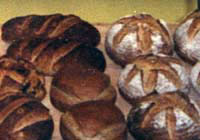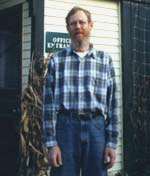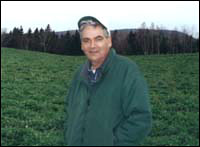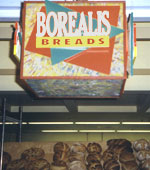And when the children of Israel saw it, many said one to another, It is manna! … And Moses said unto them, This is the bread which the Lord hath given you to eat. — Exodus, 16:15
There’s a big pile of bread at the Portland Public Market in southern Maine. These aren’t plastic-wrapped, sandwich-slice loaves; these are round loaves with hard crusts — tan and black, springy and crunchy. There’s apple cranberry, roasted red pepper, multigrain, rye, olive, Italian, organic whole wheat. The Italian bread is light, a perfect companion for sweet butter and jam; the whole wheat bread is heavy, a tool you might use to sop up stew.

Manna from heaven.
Photo: Bryan Foster.
The baker of these creations, Borealis Breads — named for the dancing northern lights — is one of Maine’s most successful businesses. Founded in 1993, Borealis has grown from one to 55 employees.
Borealis Founder Jim Amaral is the president of Maine Businesses for Social Responsibility, a group that includes Tom’s of Maine and the College of the Atlantic. MBSR encourages businesses to conserve energy and recycle materials, profit-share with employees, and invest in a socially responsible manner.
For its part, Borealis has increased the organic wheat production in the state tenfold, to 240 acres. Over the next five years, Amaral wants to increase production to 1,000 acres and build a local mill to process the grain. He said, “Maine is already known for its lobsters and blueberries. I want it to be known for its organic wheat too.”
This past November, I spent a week in Maine, traveling from Massachusetts to Nova Scotia, to learn about the people and processes that go into making Borealis’s organic bread.
The Seed Man
Johnny’s Selected Seeds is where the bread starts. Located in the central Maine town of Albion, Johnny’s is New England’s largest seed producer.
The fields around Johnny’s look like a watercolor painting. Peppers are smashed on the ground like splattered paint; leeks and turnips are upturned, their roots tousled hair; sunflowers bend their heads; cauliflower stands shrouded in elaborate layers of leaves like an origami puzzle; and heavy-topped grain goes this way and that with the breeze. Researchers take samples of the plants and seeds and test them for taste, seed yield, protein content, and appearance. The winners go to fields to be grown into seed.

Rob Johnston of Johnny’s
Selected Seeds.
Photo: Bryan Foster.
“Seeds are the first step in creating good food,” said Rob Johnston, a tall bearded man who founded Johnny’s Seeds in 1973 and still rides an old bike to work. “This is my way of helping people’s gardens become successful, helping their farms stay in business.”
Johnston carries about 10 percent organic seed, grown without synthetic fertilizers, herbicides, pesticides, or fungicides, but said that he won’t become a 100 percent organic seed company. “I carry seeds that produce tasty, hearty crops,” he said. “I like organics but a lot of the organic farmers we’ve contracted with have had crop failures, and we can’t afford that on a large scale.”
One farmer I met said that all he needs to farm is the Johnny’s seed catalog. “It’s my bible,” he said, “from here I can learn how to plant the crop, what it needs and how it will turn out.”
The Wheat Farmer
I’m in a kitchen, by a pellet stove that’s kicking out heat. It’s an early November day that makes me think of frost and pumpkins. Organic farmer and extension agent Matt Williams is talking wheat.

Matt Williams, organic farmer.
Photo: Bryan Foster.
“In the 1800s, Maine was the bread basket for the Northeast,” he said, “but then thousands of acres were plowed for grain in the Midwest and West. Maine’s small farmers turned to broccoli and potatoes.” Now, with Borealis offering $7.50 per bushel (60 pounds) for quality organic wheat (three times the market rate for conventional wheat), a cluster of farmers all along the Canadian border are growing wheat once again.
Most farms in Maine are second- or third-generation, Williams said, and still have a grandfather who remembers some of the old farming methods — tricks used to keep weeds down and soil fertility up before the chemical and industrial revolution of World War II. “Organic agriculture rewards the art of farming,” he said. “It forces you to think creatively.” Organic foods are also increasingly profitable because they can be marketed from the farmer directly to health food stores, farmers markets, or gourmet restaurants (organic foods now make up 10 percent of the $300 billion food market).
“I think that most farmers are willing to try new crops and new ways of doing things,” Williams said. “But conventional farmers need to realize that there’s a learning curve with organic farming. It takes three to four years for the soil to build up natural fertility before you get high yields.”
For neighboring farmers who wish to experiment with organic grain, Williams offers grain silos on his property to store the crop, and equipment on loan for planting, cultivating, and harvesting. He also passes along information he’s learned from working the dirt.
Williams controls weeds in his organic wheat in a variety of ways: he makes a stale seed bed by deep-plowing in early May and then waiting a couple weeks to plant so that he can go in and lightly disc away the weeds he exposed; he plants tight and dense, making a wheat canopy, with twice as much seed per acre as conventional farms; and he uses specialized weeding equipment, like a Lely cultivator and a rotary hoe.
Before I left, Williams told me, “Borealis Breads is unique. They contract directly with the farmer and mill rather than just buying bulk flour. They are making farmers important again as people who grow our food.” The faces and stories of these farmers are now pictured on baseball cards that accompany the bread: Matt Williams, extension agent and organic farmer; Dick York, organic farmer and owner of an auto dealership; Jim Cook, a Santa Claus lookalike, who is starting to grow organic wheat after years of organic potato growing.
The Miller (Wherein “Grist” Makes a Cameo)
Speerville Mill is a small place, just south of the Canadian border. The mill is in a lumpy, fairy-tale stone building surrounded by bright, corrugated steel silos. A barn nearby is similarly old-and-new, with a tin roof but gray wooden sides that lean in against each other.

Stu Fleischer of Speerville Mill.
Photo: Bryan Foster.
“Growing organic grain isn’t a voodoo trick, most anyone with some intelligence and persistence can do it,” said mill founder Stu Fleischacher. “And if farmers grow organic grain up here, we’ll buy it.” Fleischacher said that now almost half of their organic flours and cereals go to big supermarket chains. The other portion he sells to bakeries, such as Borealis Breads, and health food stores. As in much of the organic food industry, business at the mill has grown 15 to 20 percent in recent years.
Fleischacher walks me through the milling process. First the wheat is run through a cyclone heater to drain any moisture. Metal augers twist the wheat into storage silos, then back into the mill. Once inside, the wheat is shaken on screens and rolled down metal spirals to separate out the weed seed. Then two stones grist the wheat into flour
. Fans blow the flour into bags. “We stone grind all of our grain,” Fleischacher said. “Steel grinding is faster, but you must remove the bran and the wheat germ, which is the embryo, the life force of the wheat.”
The Baker
Borealis founder Jim Amaral started baking bread when he was in high school, though it took him years, after college and traveling and winemaking, to get back to it. “Bread is so interesting because it’s alive,” he said, “and you can make it all from local ingredients.”

The Borealis Bread store.
Photo: Bryan Foster.
Borealis loaves begin with a starter made from something simple, like fermented juice and flour. The whole wheat recipe combines starter, spring water, sea salt, and organic whole wheat flour. The ingredients are mixed by machine, but gently, so as not to break down the gluten of the wheat. Then the dough is set down in a proofing room, whose air smells good enough to eat, to encourage rising. The dough stays in the room for four to eight hours, allowing the long fermentation that gives artisan breads their build and flavor.
The risen dough is shaped by hand into loaves — round boules or long baguettes — and scored on top with a razor blade to release pressure during baking. The ovens are lined with stone to evenly distribute the heat; standard loaves bake at 485F for 35 minutes. Steam, shot into the oven from pipes, helps the loaves develop a hard crust. The loaves are taken from the oven on wooden peels and transferred to a stretch of canvas to cool before being labeled and bagged.
I later ate a piece of Borealis bread, ripping the crust with my teeth and scooping out the inner crumb with my tongue. It was manna.

